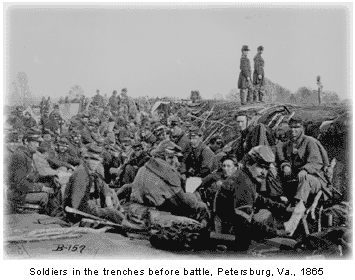Siege of Petersburg
Petersburg, Virginia, a port city on the Appomattox River, guarded the road and railway approaches to Richmond from the south.
Following the costly campaign at Cold Harbor, Grant disguised his movements from Lee, crossed the James River and moved southward. The initial assault on Petersburg was nearly successful, but the failure of Benjamin F. Butler to bring reinforcements in a timely manner ended the Union hope for a quick victory. Lee arrived and took up a defensive position in the city.
 Grant, having sustained heavy losses in the initial assault on the city, decided to set up a siege. Preparations began June 20; the siege of Petersburg lasted more than nine months, which included the bitter winter of 1864-65. Grant remained in place to check Lee, but initiated actions on other fronts:
Grant, having sustained heavy losses in the initial assault on the city, decided to set up a siege. Preparations began June 20; the siege of Petersburg lasted more than nine months, which included the bitter winter of 1864-65. Grant remained in place to check Lee, but initiated actions on other fronts:
Lee created a diversion by sending General
Jubal A. Early on a campaign to
threaten Washington, D.C.
One major effort was undertaken by the Union forces to take Petersburg during the siege, the
Battle of the Crater in July 1864.
At the time, Grant was roundly criticized for his seeming inaction. However, his critics failed to recognize the fact that by restraining Lee, Sherman was unopposed in laying waste to Georgia and the Carolinas. The Southern capacity to make war and its willingness to do so were being severely weakened.
Recognizing waning prospects, Lee abandoned Petersburg on April. Confederate officials and many of the remaining population fled from Richmond. Fires broke out in the Confederate capital, causing tremendous damage. Union soldiers, led by
black infantrymen, marched into the city. Lincoln accompanied the soldiers and viewed the devastation.
 Grant, having sustained heavy losses in the initial assault on the city, decided to set up a siege. Preparations began June 20; the siege of Petersburg lasted more than nine months, which included the bitter winter of 1864-65. Grant remained in place to check Lee, but initiated actions on other fronts:
Grant, having sustained heavy losses in the initial assault on the city, decided to set up a siege. Preparations began June 20; the siege of Petersburg lasted more than nine months, which included the bitter winter of 1864-65. Grant remained in place to check Lee, but initiated actions on other fronts: